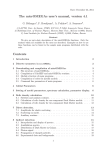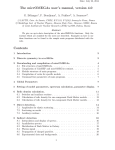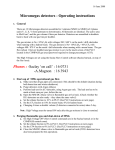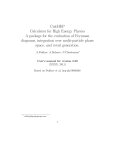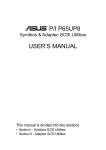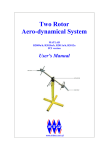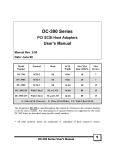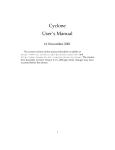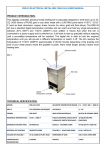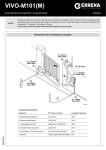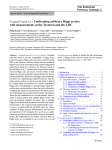Download The micrOMEGAs user`s manual, version 3.6 - LAPTh
Transcript
Date: February 4, 2014 The micrOMEGAs user’s manual, version 3.6 G. Bélanger1 , F. Boudjema1 , A. Pukhov2 , A. Semenov3 . 1) LAPTH, Univ. de Savoie, CNRS, B.P.110, F-74941 Annecy-le-Vieux, France 2) Skobeltsyn Inst. of Nuclear Physics, Moscow State Univ., Moscow 119992, Russia 3) Joint Institute for Nuclear Research (JINR) 141980, Dubna, Russia Abstract We give an up-to-date description of the micrOMEGAs functions. Only the routines which are available for the users are described. Examples on how to use these functions can be found in the sample main programs distributed with the code. Contents 1 Introduction 3 2 Downloading and compilation of micrOMEGAs. 2.1 File structure of micrOMEGAs. . . . . . . . . . . . . . 2.2 Compilation of CalcHEP and micrOMEGAs routines. 2.3 Module structure of main programs. . . . . . . . . . . . 2.4 Compilation of codes for specific models. . . . . . . . . 2.5 Command line parameters of main programs. . . . . . 3 4 4 5 6 6 3 . . . . . . . . . . . . . . . . . . . . . . . . . . . . . . . . . . . . . . . . . . . . . . . . . . . . . . . Global Parameters 7 4 Setting of parameters, spectrum calculation, parameter display. 7 5 9 Relic density calculation. 6 Direct detection. 6.1 Amplitudes for elastic scattering . . . . . . . . . . . . . . . . . . . . . . . . 6.2 Scattering on nuclei . . . . . . . . . . . . . . . . . . . . . . . . . . . . . . . 6.3 Auxiliary routines . . . . . . . . . . . . . . . . . . . . . . . . . . . . . . . . 12 12 12 14 7 Indirect detection 7.1 Interpolation and display of spectra . 7.2 Annihilation spectra . . . . . . . . . . 7.3 Distribution of Dark Matter in Galaxy. 7.4 Photon signal . . . . . . . . . . . . . . 7.5 Propagation of charged particles. . . . 7.6 Background . . . . . . . . . . . . . . . 14 14 14 15 16 17 17 8 . . . . . . . . . . . . . . . . . . . . . . . . Neutrino signal from the Sun and the Earth 9 Cross sections and decays. . . . . . . . . . . . . . . . . . . . . . . . . . . . . . . . . . . . . . . . . . . . . . . . . . . . . . . . . . . . . . . . . . . . . . . . . . . . . . . . . . . . . . . . . . . . . . . . . 18 18 1 10 Tools for model independent analysis 20 11 Constraints on the Higgs sector 21 12 Additional routines for specific 12.1 MSSM . . . . . . . . . . . . . 12.2 The NMSSM . . . . . . . . . 12.3 The CPVMSSM . . . . . . . . models 22 . . . . . . . . . . . . . . . . . . . . . . . . . 22 . . . . . . . . . . . . . . . . . . . . . . . . . 24 . . . . . . . . . . . . . . . . . . . . . . . . . 25 13 Tools for new model implementation. 13.1 Main steps . . . . . . . . . . . . . . . . 13.2 Automatic width calculation . . . . . . . 13.3 Using LanHEP for model file generation. 13.4 QCD functions . . . . . . . . . . . . . . 13.5 SLHA reader . . . . . . . . . . . . . . . 13.5.1 Writing an SLHA input file . . . 13.6 Routines for diagonalisation. . . . . . . . . . . . . . . . . . . . . . . . . . . . . . . . . . . . . . . . . . . . . . . . . . . . . . . . . . . . . . . . . . . . . . . . . . . . . . . . . . . . . . . . . . . . . . . . . . . . . . . . . . . . . . . . . . . . . . . . . . . . . . . . . . . . . . . . . . . . . 25 25 26 26 27 28 30 31 14 Mathematical tools. 32 A An updated routine for b → sγ in the MSSM 33 2 1 Introduction micrOMEGAs is a code to calculate the properties of cold dark matter(CDM) in a generic model of particle physics. First developed to compute the relic density of dark matter, the code also computes the rates for dark matter direct and indirect detection. It is assumed that a discrete symmetry like R-parity (which is even for all standard particles and odd for some new particles including the dark matter candidate) ensures the stability of the lightest odd particle (LOP) 1 . All annihilation and coannihilation channels are included in the computation of the relic density. This manual gives an up-to-date description of all micrOMEGAs functions. The methods used to compute the different dark matter properties are described in references [1, 2, 3, 4, 5, 6]. These references also contain a more complete description of the code. In the following the cold dark matter candidate also called LOP or weakly-interactive massive particle (WIMP) will be denoted by χ. micrOMEGAs contains both C and Fortran routines. Below we describe only the Cversion of the routines, in general we use the same names and the same types of argument for both C and Fortran functions. We always use double(real*8) variables for float point numbers and int(INTEGER) for integers. In this manual we use FD for file descriptor variables, the file descriptors are FILE* in C and channel number in Fortran. The symbol & before the names of variables in C-functions stands for the address of the variable. It is used for output parameters. In Fortran calls there is no need for & since all parameters are passed via addresses. In C programs one can substitute NULL for any output parameter which the user chooses to ignore. In Fortran one can substitute cNull, iNull, r8Null for unneeded parameters of character, integer and real*8 type respectively. A few C-functions use pointer variables that specify an address in the computer memory. Because pointers do not exist in Fortran one uses any other type of variable whose length is sufficient to store a computer address, for example INTEGER*8. The complete format for all functions can be found in sources/micromegas.h (for C) or sources/micromegas_f.h (for Fortran). Examples on how to use these functions are provided in the MSSM/main.c[F] file. micrOMEGAs exploits the fact that models of dark matter exhibit a discrete symmetry. This is responsible for the stability of the dark matter candidate. micrOMEGAs assumes that all particles that are odd under the discrete symmetry have a name starting with ’~’, for example ~o1 for the lightest neutralino. 2 Downloading and compilation of micrOMEGAs. To download micrOMEGAs, go to http://lapth.cnrs.fr/micromegas and unpack the file received, micromegas_3.X.tgz, with the command tar -xvzf micromegas_3.X.tgz This should create the directory micromegas_3.X/ which occupies about 40 Mb of disk space. You will need more disk space after compilation of specific models and generation of matrix elements. In case of problems and questions email: [email protected] 1 Z3 discrete symmetries are also handled by micrOMEGAs. 3 2.1 File structure of micrOMEGAs. Makefile to compile the kernel of the package CalcHEP_src/ generator of matrix elements for micrOMEGAs Packages/ external codes clean to remove compiled files man/ — contains the manual: description of micrOMEGAs routines newProject to create a new model directory structure sources/ micrOMEGAs code MSSM model directory MSSM/ Makefile to compile the code and executable for this model main.c[pp] main.F files with sample main programs lib/ directory for routines specific to this model Makefile to compile the auxiliary code library lib/aLib.a *.c *.f source codes of auxiliary functions work/ CalcHEP working directory for the generation of matrix elements Makefile to compile the library work/work aux.a models/ directory for files which specifies the model vars1.mdl free variables func1.mdl constrained variables prtcls1.mdl particles lgrng1.mdl Feynman rules tmp/ auxiliary directories for CalcHEP sessions results/ so_generated/ storage of matrix elements generated by CalcHEP calchep/ directory for interactive CalcHEP sessions Directories of other models which have the same structure as MSSM/ NMSSM/ Next-to-Minimal Supersymmetric Model[24, 17] CPVMSSM/ MSSM with complex parameters[27, 16] IDM/ Inert Doublet Model[8] LHM/ Little Higgs Model[7] RHNM/ Right-handed Neutrino Model[22] SM4/ Toy model with a 4th generation of lepton and neutrino DM Z3M/ A model with scalar DM and Z3 discrete symmetry—[9] mdlIndep/ For model independent computation of DM signals 2.2 Compilation of CalcHEP and micrOMEGAs routines. CalcHEP and micrOMEGAs are compiled by gmake. Go to the micrOMEGAs directory and launch gmake If gmake is not available, then make should work like gmake. In principle micrOMEGAs defines automatically the names of C and Fortran compilers and the flags for compilation. If you meet a problem, open the file which contains the compiler specifications, 4 CalcHEP_src/FlagsForSh, improve it, and launch [g]make again. The file is written is sh script format and looks like # C compiler CC="gcc" # Flags for C compiler CFLAGS="-g -fsigned-char" # Disposition of header files for X11 HX11= # Disposition of lX11 LX11="-lX11" # Fortran compiler FC="gfortran" FFLAGS="-fno-automatic" ........ After a successful definition of compilers and their flags, micrOMEGAs rewrites the file FlagsForSh into FlagsForMake and substitutes its contents in all Makefiles of the package. [g]make clean deletes all generated files, but asks permission to delete FlagsForSh. [g]make flags only generates FlagsForSh. It allows to check and change flags before compilation of codes. 2.3 Module structure of main programs. Each model included in micrOMEGAs is accompanied with sample files for C and Fortran programs which call micrOMEGAs routines, the main.c, main.F files. These files consist of several modules enclosed between the instructions #ifdef XXXXX .................... #endif Each of these blocks contains some code for a specific problem #define #define #define #define #define #define #define #define #define #define #define #define #define MASSES_INFO //Displays information about mass spectrum CONSTRAINTS //Displays B_>sgamma, Bs->mumu, etc OMEGA //Calculates the relic density INDIRECT_DETECTION //Signals of DM annihilation in galactic halo LoopGAMMA //Gamma-Ray lines - available only in some models RESET_FORMFACTORS //Redefinition of Form Factors and other //parameters CDM_NUCLEON //Calculates amplitudes and cross-sections //for DM-nucleon collisions CDM_NUCLEUS //Calculates number of events for 1kg*day //and recoil energy distribution for various nuclei NEUTRINO //Calculates flux of solar neutrinos and //the corresponding muon flux DECAYS //Calculates decay widths and branching ratios CROSS_SECTIONS //Calculates cross sections CLEAN // Removes intermediate files. SHOWPLOTS //Displays graphical plots on the screen 5 Other modules which require a link to external programs can also be defined, in this case the path to the required code must be specified, for example #define HIGGSBOUNDS "../Packages/HiggsBounds-4.0.0" All these modules are completely independent. The user can comment or uncomment any set of define instructions to suit his/her need. 2.4 Compilation of codes for specific models. After the compilation of micrOMEGAs one has to compile the executable to compute DM related observables in a specific model. To do this, go to the model directory, say MSSM, and launch [g]make main=main.c It should generate the executable main. In the same manner gmake main=filename.ext generates the executable filename based on the source file filename.ext. For ext we support 3 options: ’c’ , ’F’, ’cpp’ which correspond to C, FORTRAN and C++ sources. [g]make called in the model directory automatically launches [g]make in subdirectories lib and work to compile lib/aLib.a - library of auxiliary model functions, e.g. constraints, work/work_aux.a - library of model particles, free and dependent parameters. 2.5 Command line parameters of main programs. The default versions of main.c/F programs need some arguments which have to be specified in command lines. If launched without arguments main explains which parameter are needed. As a rule main needs the name of a file containing the numerical values of the free parameters of the model. The structure of a file record should be Name Value # comment ( optional) For instance, an Inert Doublet model (IDM) input file contains Mh MHC MH3 MHX la2 laL 125 200 200 63.2 0.01 0.01 # # # # # # mass of SM Higgs mass of charged Higgs ~H+ mass of odd Higgs ~H3 mass of ~X particle \lambda_2 coupling 0.5*(\lambda_3+\lambda_4+\lambda_5) In other cases, different inputs can be required. For example, in the MSSM with input parameters defined at the GUT scale, the parameters have to be provided in a command line. Launching ./main will return This program needs 4 parameters: m0 common scalar mass at GUT scale mhf common gaugino mass at GUT scale a0 trilinear soft breaking parameter at GUT scale tb tan(beta) 6 Auxiliary parameters are: sgn +/-1, sign of Higgsino mass term (default 1) Mtp top quark pole mass MbMb Mb(Mb) scale independent b-quark mass alfSMZ strong coupling at MZ Example: ./main 120 500 -350 10 1 173.1 3 Global Parameters The list of the global parameters and their default values are given in Tables 1, 2. The numerical value for any of these parameters can be simply reset anywhere in the code. Table 1: Global parameters of micrOMEGAs Name Mcdm deltaY dmAsymm K dif L dif Delta dif Tau dif Vc dif Fermi a Fermi b Fermi c Rsun Rdisk rhoDM Vearth Vrot Vesc 4 default value units GeV 0 0 0.0112 kpc2 /Myr 4 kpc 0.7 1016 GeV·s 0 km/s 0.52 fm -0.6 fm 1.23 fm 8.5 kpc 20 kpc 0.3 GeV/cm3 225.2 km/s 220 km/s 600 km/s comments Mass of the Dark Matter particle Difference between DM/anti-DM abundances Asymmetry between relic density of DM- anti-DM The normalized diffusion coefficient Vertical size of the Galaxy diffusive halo Slope of the diffusion coefficient Electron energy loss time Convective Galactic wind nuclei surface thickness parameters to set the nuclei radius with RA = cA1/3 + b Distance from the Sun to the center of the Galaxy Radius of the galactic diffusion disk Dark Matter density at Rsun Galaxy velocity of the Earth Galaxy rotation velocity at Rsun Escape velocity at Rsun Setting of parameters, spectrum calculation, parameter display. The independent parameters that characterize a given model are listed in the file work/models/vars1.mdl. Three functions can be used to set the value of these parameters: • assignVal(name,val) • assignValW(name,val) 7 Table 2: Global parameters of micrOMEGAs: nucleon quark form factors Proton Name ScalarFFPd ScalarFFPu ScalarFFPs pVectorFFPd pVectorFFPu pVectorFFPs SigmaFFPd SigmaFFPu SigmaFFPs value 0.0191 0.0153 0.0447 -0.427 0.842 -0.085 -0.23 0.84 -0.046 Neutron Name ScalarFFNd ScalarFFNu ScalarFFNs pVectorFFNd pVectorFFNu pVectorFFNs SigmaFFNd SigmaFFNu SigmaFFNs value 0.0273 0.011 0.0447 0.842 -0.427 -0.085 0.84 -0.23 -0.046 comments Scalar form factor Axial-vector form factor Tensor form factor assign value val to parameter name. The function assignVal returns a non-zero value if it cannot recognize a parameter name while assignValW writes an error message. • readVar(fileName) reads parameters from a file. The file should contain two columns with the following format (see also ) name value readVar returns zero when the file has been read successfully, a negative value when the file cannot be opened for reading and a positive value corresponding to the line where a wrong file record was found. Note that in Fortran, numerical constants should be specified as Real*8, for example call assignValW(’SW’, 0.473D0) A common mistake is to use Real*4. The constrained parameters of the model are stored in work/models/func1.mdl. Some of these parameters are treated as public parameters. The public parameters include by default all particle masses and all parameters whose calculation requires external functions (except simple mathematical functions like sin, cos .. ). The parameters listed above any public parameters in work/models/func1.mdl are also treated as public. It is possible to enlarge the list of public parameters. There are two ways to do this. One can type * before a parameter name to make it public or one can add a special record in work/models/func1.mdl %Local! | Then all parameters listed above this record become public. See example in MSSM/work/models/func1.mdl The calculation of the particle spectrum and of all public model constraints is done with: • sortOddParticles(txt) 8 which also sorts the odd particles with increasing masses, writes the name of the lightest odd particle in txt and assigns the value of the mass of the lightest odd particle to the global parameter Mcdm. This routine returns a non zero error code for a wrong set of parameters, for example parameters for which some constraint cannot be calculated. The name of the corresponding constraint is written in txt. This routine has to be called after a reassignment of any input parameter. • qNumbers(pName, &spin2,&charge3,&cdim) returns the quantum numbers for the particle pName. Here spin2 is twice the spin of the particle; charge3 is three times the electric charge; cdim is the dimension of the representation of SU (3)c , it can be 1, 3, −3 or 8. The parameters spin2, charge3, cdim are variables of type int. The value returned is the PDG code. If pName does not correspond to any particle of the model then qNumbers returns zero. • nextOdd(n, &pMass) returns the name and mass of the nth odd particle assuming that particles are sorted according to increasing masses. For n = 0 the output specifies the name and the mass of the CDM candidate. In the FORTRAN version this function is Subroutine nextOdd(n,pName,pMass) • pdg2name(nPDG) returns the name of the particle which PDG code is nPDG. If this particle does not exist in the model the return value is NULL. In the FORTRAN version this function is Subroutine pdg2name(nPDG, pName) and the character variable pName consists of white spaces if the particle does not exist in the model. • pMass(pName) returns the numerical value of the particle mass. • findVal(name,&val) finds the value of variable name and assigns it to parameter val. It returns a non-zero value if it cannot recognize a parameter name. • findValW(name) just returns the value of variable name and writes an error message if it cannot recognize a parameter name. The variables accessible by these commands are all free parameters and the constrained parameters of the model (in file model/func1.mdl) treated as public. The following routines are used to display the value of the independent and the constrained public parameters: • printVar(FD) prints the numerical values of all independent and public constrained parameters into FD • printMasses(FD, sort) prints the masses of ’odd’ particles (those whose names started with ~). If sort 6= 0 the masses are sorted so the mass of the CDM is given first. • printHiggsMasses(FD, sort) prints the masses and widths of ’even’ scalars. 5 Relic density calculation. • vSigma(T,Beps,fast) calculates the thermally averaged cross section for DM annihilation times velocity at a temperature T [GeV], see formula (2.6) in [1]. The value for σv is expressed in [pb]. The 9 parameter Beps defines the criteria for including coannihilation channels as for darkOmega described below. The f ast = 1/0 option switches between the fast/accurate calculation. The global array vSigmaTCh contains the contribution of different channels to vSigma. vSigmaTCh[i].weight specifies the relative weight of the ith channel vSigmaTCh[i].prtcl[j] (j=0, 4) defines the particles names for the ith channel. The last record in vSigmaTCh array has zero weight and NULL particle names. In the Fortran version, the function vSigmaTCh(i,weight,pdg,process)serves the same purpose. This function returns 0 if i exceeds the number of annihilation channels and 1 otherwise, i ≥ 1. real*8 weight gives the relative contribution of each annihilation channel. integer pdg(5) contains the codes of incoming and outgoing particles in the annihilation process. character*40 process contains a textual description of annihilation processes. The cross sections for semi - annihilation processes contribute to vSigma with a factor 21 as described in [9]. Furthermore if an outgoing particle has a non-zero decay branching ratio to odd particles, then the annihilation cross section is reduced correspondingly. • darkOmega(&Xf,fast,Beps) calculates the dark matter relic density Ωh2 . This routine solves the differential evolution equation using the Runge-Kutta method. Xf = M cdm/Tf characterizes the freeze-out temperature. The value of Xf is given for information and is also used as an input for the routine that gives the relative contribution of each channel to Ωh2 , see printChannels below. The f ast = 1 flag forces the fast calculation (for more details see Ref. [2]). This is the recommended option and gives an accuracy around 1%. The parameter Beps defines the criteria for including a given coannihilation channel in the computation of the thermally averaged cross-section, [2]. The recommended value is Beps = 10−4 − 10−6 whereas if Beps = 1 only annihilation of the lightest odd particle is computed. • darkOmegaFO(&Xf, fast, Beps) calculates the dark matter relic density Ωh2 using the freeze-out approximation. • printChannels(Xf,cut,Beps,prcnt,FD) writes into FD the contributions of different channels to (Ωh2 )−1 . Here Xf is an input parameter which should be evaluated first in darkOmega[FO]. Only the channels whose relative contribution is larger than cut will be displayed. Beps plays the same role as the darkOmega[FO] routine. If prcnt 6= 0 the contributions are given in percent. Note that for this specific purpose we use the freeze-out approximation. • oneChannel(Xf,Beps,p1,p2,p3,p4) calculates the relative contribution of the channel p1, p2 → p3, p4 to (Ωh2 )−1 . p1,...,p4 are particle names. To sum over several channels one can write "*" instead of a particle name, e.g "*" in place of p1. • omegaCh is an array that contains the relative contribution and particle names for each annihilation channel. In the Fortran version one uses instead the function omegaCh(i,weight,pdg,process). These array and function are similar to vSigmaTCh described above. The array omegaCh if filled after calling either darkOmegaFO or printChannels. •improveCrossSection( p1,p2,p3,p4, Pcm, &address) allows to substitute a new cross-section for a given process. Here p1,p2 are the names of particles in the initial state and p3,p4 those in the final state. Pcm is the center of mass momentum and address ... This function is useful if for example the user wants to include her/his one-loop improved cross-section calculation in the relic density computation. •VWdecay,VZdecay Switches to turn on/off processes with off-shell gauge bosons in the final state for DM an10 nihilation and particle decays. If VW/VZdecay=1, the 3-body final states will be computed for annihilation processes only while if VW/VZdecay=2 they will be included in coannihilation processes as well. By default the switches are set to (VW/VZdecay=1). 2 Note that micrOMEGAs calculates the width of each particle only once and stores the result in Decay Table. A second call to the function pWidth (whether an explicit call or within the computation of a cross section) will return the same result even if the user has changed the VW/VZdecay switch. We recommend to call •cleanDecayTable() after changing the switches to force micrOMEGAs to recalculate the widths taking into account the new value of VW/VZdecay. In Fortran, the subroutine • setVVdecay(VWdecay,VZdecay) changes the switches and calls cleanDecayTable(). The sortOddParticles command which must be used to recompute the particle spectrum after changing the model parameters also clears the decay table. If the particle widths were stored in the SLHA file (Susy Les Houches Accord [18]) downloaded by micrOMEGAs, then the SLHA value will be used by and are thus insensitive to the VW/VZdecay switches. To avoid downloading particle widths, one can use slhaRead(fileName,mode=4) to read the content of the SLHA file, see the description in Section 13.5. Two new global parameters are available to set the DM asymmetry: •deltaY describes the difference between the DM and anti-DM abundances for the models where number of DM paricles minus number of anti-DM ones is conserved in reactions of decay and collisions. In such models deltaY is a constant during thermal evolution of Univerce. See Ref. [6]. •dmAsymm is defined by equation 1 ± dmAsymm Ω± = Ω 2 and evaluated by micrOMEGAs while calculating the relic density with an initial asymmetry deltaY. See [6]. This parameter can also be reset after the relic density computation and will be taken into account for direct and indirect detection rates. The temperature dependence of the effective number of degrees of freedom can be set with • loadHeffGeff(char*fname) allows to modify the temperature dependence of the effective number of degrees of freedom by loading the file fname which contains a table of hef f (T ), gef f (T ) . A positive return value corresponds to the number of lines in the table. A negative return value indicates the line which creates a problem (e.g. wrong format), the routine returns zero when the file fname cannot be opened. The default file is std_thg.tab and is downloaded automatically if loadHeffGeff is not called is user’s main program. Five other files are provided in the sources/data directory: HP_A_thg.tab, HP_B_thg.tab, HP_B2_thg.tab, HP_B3_thg.tab, and HP_C_thg.tab. They correspond to sets A, B, B2, B3, C in [10]. The user can substitute his/her own table as well, if so, the file must contain three columns containing the numerical values for T , hef f , gef f , the data file can also contain comments for lines starting with #. 2 Including the 3-body final states can significantly increase the execution time for the relic density. 11 6 Direct detection. 6.1 Amplitudes for elastic scattering • nucleonAmplitudes(qBOX,pAsi,pAsd,nAsi,nAsd) calculates the amplitudes for WIMP-nucleon elastic scattering at zero momentum. pAsi(nAsi) are spin independent amplitudes for protons(neutrons) whereas pAsd(nAsd) are the corresponding spin dependent amplitudes. Each of these four parameters is an array of dimension 2. The zeroth (first) element of these arrays gives the χ-nucleon amplitudes whereas the second element gives χ-nucleon amplitudes. Amplitudes are normalized such that the total cross section for either χ or χ cross sections is3 σtot 4Mχ2 MN2 = (|ASI |2 + 3|ASD |2 ) 2 π(Mχ + MN ) (1) If qBOX=NULL (qBOX=NoLoop in Fortran) tree level amplitudes are computed. In MSSMtype models with a spin 1/2 WIMP and scalar ”squarks”, qBOX=FeScLoop uses an improved tree-level calculation. nucleonAmplitudes returns a value different from zero only when there is an internal problem in the calculation. nucleonAmplitudes depends implicitly on form factors which describe the quark contents in the nucleon. These form factors are global parameters (see Table 1 for default values) T ypeFFPq T ypeFFNq where T ype is either ”Scalar”, ”pVector”, or ”Sigma”, FFP and FFN denote proton and neutron and q specifies the quark, d, u or s. Heavy quark coefficients are calculated automatically. • calcScalarQuarkFF(mu /md ,ms /md ,σπN ,σs ) computes the scalar coefficients for the quark content in the nucleon from the quark mass ratios mu /md , ms /md as well as from σπN and σs . The default values given in Table 2 are obtained for σs = 42MeV, σπN = 34MeV, mu /md = 0.56, ms /md = 20.2 [11]. The function calcScalarQuarkFF(0.553,18.9,55.,243.5) will reproduce the default values of the scalar quark form factors used in micrOMEGAs2.4 and earlier versions. 6.2 Scattering on nuclei • nucleusRecoil(f,A,Z,J,Sxx,qBOX,dNdE) This is the main routine of the direct detection module. The input parameters are: f - the DM velocity distribution normalized such that Z ∞ vf (v)dv = 1 0 The units are km/s for v and s2 /km2 for f(v). A - atomic number of nucleus; 3 All parameters are in GeV. 12 Z - number of protons in the nucleus, predefined values for a wide set of isotopes are called with Z {N ame}; J - nucleus spin, predefined values for a wide set of isotopes are called with J {N ame}{atomic number}. Sxx - is a routine which calculates nucleus form factors for spin-dependent interactions (S00,S01,S11), it depends on the momentum transfer in f m−1 . The available form factors are SxxF19 SxxK39 SxxI127 SxxXe131 SxxNa23 SxxGe73 SxxI127A SxxXe131A SxxNa23A SxxAl27 SxxSi29 SxxGe73A SxxNb92 SxxTe125 SxxXe129 SxxXe129A SxxXe131B SxxSi29A SxxTe125A The last character is used to distinguish different implementations of the form factor for the same isotope, see details in [4]. qBOX - a parameter needed by nucleonAmplitudes, see the description above. The form factors for the spin independent (SI) cross section are defined by a Fermi distribution and depend on the global parameters Fermi_a, Fermi_b, Fermi_c. The returned value gives the number of events per day and per kilogram of detector material. The result depends implicitly on the global parameter rhoDM, the density of DM near the Earth. The distribution over recoil energy is stored in the array dN dE which by default has N step = 200 elements. The value in the ith element corresponds to dN dE[i] = dN |E=i∗keV ∗step dE in units of (1/keV/kg/day). By default step is set to 1. For a complex WIMP, nucleusRecoil averages over χ and χ. For example for a call to this routine will be: 73 Ge, nucleusRecoil(Maxwell,73,Z_Ge,J_Ge73,SxxGe73,FeScLoop,dNdE); • setRecoilEnergyGrid(step,Nstep) changes the values of step and Nstep for the computation of dNdE. • Maxwell(v) returns Z cnorm (~v − VEarth )2 3 f (v) = d ~v exp − δ(v − |~v |) v ∆v 2 |~v |<vmax which corresponds to the isothermal model. Default values for the global parameters ∆v = Vrot, vmax = Vesc, Vearth are listed in Table 1. cnorm is the normalization factor. This function is an argument of the nucleusRecoil function described above. • nucleusRecoil0(f,A,Z,J,Sp,Sn,qBOX,dNdE) is similar to the function nucleusRecoil except that the spin dependent nuclei form factors are described by Gauss functions whose values at zero momentum transfer are 13 defined by the coefficients Sp,Sn [4]. Predefined values for the coefficients Sp,Sn are included for the nuclei listed in nucleusrecoil as well as 3 He, 133 Cs. Their names are Sp {N ucleus N ame}{Atomic N umber} Sn {N ucleus N ame}{Atomic N umber} One can use this routine for nuclei whose form factors are not known. 6.3 Auxiliary routines Two auxiliary routines are provided to work with the energy spectrum computed with nucleusRecoil and nucleusRecoil0. • cutRecoilResult(dNdE,E1,E2) calculates the number of events in an energy interval defined by the values E1,E2 in keV . • displayRecoilPlot(dNdE,title,E1,E2) plots the generated energy distribution dNdE. Here title is a character string specifying the title of the plot and E1,E2 are minimal and maximal values for the displayed energy in keV. 7 7.1 Indirect detection Interpolation and display of spectra Various spectra and fluxes of particles relevant for indirect detection are stored in arrays with NZ=250 elements. To decode and interpolate the spectrum array one can use the following functions: • SpectdNdE(E,spectTab) interpolates the tabulated spectra and returns the particle distribution dN/dE where E is the energy in GeV. For a particle number distribution the returned value is given in GeV−1 units while a particle flux is expressed in (sec cm2 sr GeV )−1 . • zInterp(z,spectTab) works as SpectdNdE(E,spectTab) but returns dN/dz where z = log(E/M cdm). To display the spectra one can use • displaySpectrum(Spectrum,message,Emin,Emax,Units) where message is a text string which gives a title to the plot and Emin and Emax define energy cuts. If Units=0 the spectrum is written as a function of z10 = log10 (E/Mcdm), otherwise the spectrum is a function of the energy in GeV. The ith element (0 ≤ i < N Z − 1) of the spectrum array contains the value of 1.5 dN/dzi where zi = log (10−7 )(i/N Z) . That is the array points cover the energy interval M cdm ≥ E > 10−7 M cdm. The function Zi(i) returns the zi grid points. 7.2 Annihilation spectra • calcSpectrum(key,Sg,Se,Sp,Sne,Snm,Snl,&err) calculates the spectra of DM annihilation at rest and returns σv in cm3 /s . The calculated spectra for γ, e+ , p̄, νe , νµ , ντ are stored in arrays of dimension NZ as described above: 14 Sg, Se, Sp, Sne, Snm, Snl. To remove the calculation of a given spectra, substitute NULL for the corresponding argument. key is a switch to include the polarisation of the W, Z bosons (key=1) or photon radiation (key=2). Note that final state photon radiation (FSR) is always included. When key=2 the 3-body process χχ0 → XX + γ is computed for those subprocesses which either contain a light particle in the t-channel (of mass less than 1.2 Mcdm) or an outgoing W when Mcdm>500GeV. The FSR is then subtracted to avoid double counting. Only the electron/positron spectrum is modified with this switch. When key=4 the contibutions for each channel to total annihilation rate are written on the screen. More than one option can be switched on simultaneously by adding the corresponding values for key. For example both the W polarization and photon radiation effects are included if key=3. A problem in the spectrum calculation will produce a non zero error code, err 6= 0. calcSpectrum interpolates and sums spectra obtained by Pythia. The spectra tables are provided only for Mcdm> 2GeV. The results for a dark matter mass below 2 GeV will therefore be wrong, for example an antiproton spectrum with kinematically forbidden energies will be produced. A warning is issued for Mcdm< 2GeV. • spectrInfo(Xmin,spectrTab,&Ntot,&Xtot) provides information on the spectra generated. Here Xmin defines the minimum cut for the energy fraction x=E/Mcdm, Ntot and Xtot are calculated parameters which give on average the total number and the energy fraction of the final particles produced per collision. Note that the upper limit is Xtot=2. • vSigmaCh is an array that contains the relative contribution and particle names for each annihilation channel. It is similar to vSigmaTCh described above, but list of particle has 5 positions to describe gamma radiation. For 2->2 processes vSigmaCh[n].prtcl[4]=NULL. The array vSigmaCh is filled by calcSpectrum. In the Fortran version one uses instead the function vSigmaCh(i,weight,pdg,process) which also is similar to Fortran vSigmaTCh described above. 7.3 Distribution of Dark Matter in Galaxy. The indirect DM detection signals depend on the DM density in our Galaxy. The DM density is given as the product of the local density at the Sun with the halo profile function ρ(r) = ρ Fhalo (r) (2) In micrOMEGAs ρ is a global parameter rhoDM and the Zhao profile [12] Fhalo (r) = R r γ α rcα + R rcα + rα β−γ α (3) with α = 1, β = 3, γ = 1, rc = 20[kpc] is used by default. R , the distance from the Sun to the galactic center, is also a global parameter, Rsun. The parameters of the Zhao profile can be reset by • setProfileZhao(α,β,γ,rc) The function to set another density profile is • setHaloProfile(Fhalo (r)) where Fhalo (r) is any function which depends on the distance from the galactic center, r, defined in [kpc] units. For instance, setHaloProfile(hProfileEinasto) sets Einasto 15 profile α 2 r Fhalo (r) = exp − −1 α R where by default α = 0.17, but can be changed by • setProfileEinasto(α) The command setHaloProfile(hProfileZhao) sets back the Zhao profile. Note that both setProfileZhao and setProfileEinasto call setHaloProfile to define the corresponding profile. Dark matter annihilation in the Galaxy depends on the average of the square of the DM density, < ρ2 >. This quantity can be significantly larger than < ρ >2 when clumps of DM are present [13]. In micrOMEGAs , we use a simple model where fcl is a constant that characterizes the fraction of the total density due to clumps and where all clumps occupy the same volume Vcl and have a constant density ρcl . Assuming clumps do not overlap, we get < ρ2 >= ρ2 + fcl ρcl ρ. (4) This simple description allows to demonstrate the main effect of clumps: far from the Galactic center the rate of DM annihilation falls as ρ(r) rather than as ρ(r)2 . The parameters ρcl and fcl have zero default values. The routine to change these values is • setClumpConst(fcl ,ρcl ) To be more general, one could assume that ρcl and fcl depend on the distance from the galactic center. The effect of clumping is then described by the equation f < ρ2 > (r) = ρ(r)(ρ(r) + ρef clump (r)), (5) and the function f • setRhoClumps(ρef clump ) allows to implement a more sophisticated clump structure. To return to the default treatment of clumps call setRhoClumps(rhoClumpsConst) or setClumpConst. 7.4 Photon signal The photon flux does not depend on the diffusion model parameters but on the angle φ between the line of sight and the center of the galaxy as well as on the annihilation spectrum into photons • gammaFluxTab(fi,dfi,sigmav,Sg,Sobs) multiplies the annihilation photon spectrum with the integral over the line of sight and over the opening angle to give the photon flux. fi is the angle between the line of sight and the center of the galaxy, dfi is half the cone angle which characterizes the detector resolution (the solid angle is 2π(1 − cos(df i)) , sigmav is the annihilation cross section, Sg is the DM annihilation spectra. Sobs is the spectra observed. The function gammaFluxTab can be used for the neutrino spectra as well. • gammaFlux(fi,dfi,vcs) is the same function as gammaFluxTab above but corresponds to a discrete photon spec trum. vcs is the annihilation cross section, for instance in the MSSM it is calculated with the loopGamma function. The function returns the number of photons per cm2 of detector surface per second. Note that for χχ → γγ the result should be multiplied by a factor 2 as each annihilation leads to the production of two photons. 16 7.5 Propagation of charged particles. The observed spectrum of charged particles strongly depends on their propagation in the Galactic Halo. The propagation depends on the global parameters K_dif, Delta_dif, L_dif, Rsun, Rdisk as well as Tau_dif (positrons), Vc_dif (antiprotons) • posiFluxTab(Emin,sigmav, Se, Sobs) computes the positron flux at the Earth. Here sigmav and Se are values obtained by calcSpectrum. Sobs is the positron spectrum after propagation. Emin is the energy cut to be defined by the user. Note that a low value for Emin increases the computation time. The format is the same as for the initial spectrum. The function SpectrdNdE(E,Sobs) described above can also be used for the interpolation, in this case the flux is returned in (GeV s cm2 sr)−1 . • pbarFlux(E,dSigmavdE) computes the antiproton flux for a given energy E and a differential cross section for antiproton production, dSigmavdE. For example, one can substitute dSigmavdE=σvSpectdNdE(E,SpP) where σv and SpP are obtained by calcSpectrum. This function does not depend on the details of the particle physics model and allows to analyse the dependence on the parameters of the propagation model. • pbarFluxTab(Emin,sigmav, Sp, Sobs) computes the antiproton flux, this function works like posiFluxTab, • solarModulation(Phi, mass, stellarTab, earthTab) takes into account the modification of the interstellar positron/antiproton flux caused by the electro-magnetic fields in the solar system. Here Phi is the effective Fisk potential in MeV, mass is the particle mass, stellarTab describes the interstellar flux, earthTab is the calculated particle flux in the Earth orbit. Note that for solarModulation and for all *FluxTab routines one can use the same array for the spectrum before and after propagation. 7.6 Background The collision of protons with the gas in the galactic disk is the main source of anti-protons and is the dominant background to the DM-induced anti-proton signal. It depends both on the proton flux and on the propagation parameters. However, all sets of propagation parameters corresponding to the measured B/C rate should provide the same p̄/p rate. Thus it is possible to provide a robust estimation of the anti-proton background. The function • pBarBackgroundFlux(E) calculates the p̄ background flux in (GeV cm2 s)−1 units using the formula of [42]. This flux can be given in an array with the format used by micrOMEGAs for other fluxes: • pBarBackgroundTab(pTab). To take into account solar modulation, one can apply to this array the solarModulation routine described above. 17 8 Neutrino signal from the Sun and the Earth After being captured, DM particles concentrate in the center of the Sun/Earth and then annihilate into Standard Model particles. These SM particles further decay producing neutrinos that can be observed at the Earth. • neutrinoFlux(f,forSun,nu, nu_bar) calculates muon neutrino/anti-neutrino fluxes near R ∞ the surface of the Earth. Here f is the DM velocity distribution normalized such that 0 vf (v)dv = 1. The units are km/s for v and s2 /km2 for f(v). At first approximation, one can use the same Maxwell function introduced for direct detection. If forSun==0 then the flux of neutrinos from the Earth is calculated, otherwise this function computes the flux of neutrinos from the Sun. The calculated fluxes are stored in nu and nu bar arrays of dimension NZ=250. The neutrino fluxes are expressed in [1/Year/km2 ]. The function SpectdNdE(E,nu) returns the differential flux of neutrinos in [1/Year/km2 /GeV], and displaySpectrum(nu,"nu from Sun [1/Year/km^2/GeV]",Emin,Emax,1) allows to display the corresponding spectrum on the screen. • muonUpward(nu,Nu,rho, muon) calculates the muon flux which results from interactions of neutrinos with rocks below the detector. Here nu and Nu are input arrays containing the neutrino/anti-neutrino fluxes calculated by neutrinoFlux. rho is the Earth density ≈ 2.6g/cm3 . muon is an array which stores the resulting sum of µ+ , µ− fluxes. SpectdNdE(E,muon) gives the differential muon flux in [1/Year/km2 /GeV] units. • muonContained(nu,Nu,rho, muon) calculates the flux of muons produced in a given detector volume.This function has the same parameters as muonUpward except that the outgoing array gives the differential muon flux resulting from neutrinos converted to muons in a km3 volume given in [1/Year/km3 /GeV] units. rho is the density of the detector in g/cm3 . Two functions allow to estimate the background from atmospheric neutrinos creating muons after interaction with rocks below the detector or with water inside the detector. • ATMmuonUpward(cosFi,E) calculates the sum of muon and anti-muon fluxes resulting from the interaction of atmospheric neutrinos with rocks in units of [1/Year/km2 /GeV/Sr]. cosFi is the energy between the direction of observation and the direction to the center of Earth. E is the muon energy in GeV. • ATMmuonContained(cosFi, E, rho) calculates the muon flux caused by atmospheric neutrinos produced in a given (detector) volume. The returned value for the flux is given in 1/Year/km3 /GeV. rho is the density of the detector in g/cm3 units. cosFi and E are the same as above. 9 Cross sections and decays. The calculation of particle widths, decay channels and branching fractions can be done by the function • pWidth(particleName,&address) returns directly the particle width. If the 1->2 decay channels are kinematically accessible 18 then only these channels are included in the width when VWdecay,VZdecay= 0. If not, pWidth compiles all open 1->3 channels and use these for computing the width. If all 1->3 channels are kinematically forbidden, micrOMEGAs compiles 1->4 channels. If VWdecay(VZdecay)6= 0, then micrOMEGAs also computes the processes with virtual W (Z) which are closed kinematically and adds these to the 1->2 decay channels. Note that 1->3 decay channels with a virtual W will be computed even if the mass of the decaying particle exceeds the threshold for 1->2 decays by several GeV’s. This is done to ensure a proper matching of 1->2 and 1->3 processes. For particles other than gauge bosons, an improved routine with 3-body processes and a matching between the 1->2 and 1->3 calculations is kept for the future. The returned parameter address gives an address where information about the decay channels is stored. In C, the address should be of type txtList. For models which read a SLHA parameter file, the values of the widths and branchings are taken from the SLHA file unless the user chooses not to read this data, see (Section 13.5) for details. • printTxtList(address,FD) lists the decays and their branching fractions and writes them in a file. address is the address returned by pWidth. • findBr(address,pattern) finds the branching fraction for a specific decay channel specified in pattern, a string containing the particle names in the CalcHEP notation. The names are separated by commas or spaces and can be specified in any order. • slhaDecayPrint(pname,FD) uses pWidth described above to calculate the width and branching ratios of particle pname and writes down the result in SLHA format. The return value is the PDG particles code. In case of problem, for instance wrong particle names, this function returns zero. This function first tries to calculate 1 → 2 decays. If such decays are kinematically forbidden then 1 → 3 decay channels are computed. • newProcess(procName) compiles the codes for any 2 → 2 or 1 → 2 reaction. The result of the compilation is stored in the shared library in the directory work/so-generated/. The name of the library is generated automatically. The newProcess routine returns the address of the compiled code for further usage. If the process can not be compiled, then a NULL address is returned4 . Note that it is also possible to compute processes with polarized massless beams, for example for a polarized electron beam use e% to designate the initial particle. • procInfo1(address,&ntot,&nin,&nout) provides information about the total number of subprocesses (ntot) stored in the library specified by address as well as the number of incoming (nin) and outgoing (nout) particles for these subprocesses. Typically, for collisions (decays), nin = 2(1) and nout = 2, 3. NULL can be substitute if this information is not needed. • procInfo2(address,nsub,N,M) fills an array of particle names N and an array of particle masses M for the subprocess nsub (1 ≤ nsub ≤ ntot) . These arrays have size nin + nout and the elements are listed in the same order as in CalcHEP starting with the initial state, see the example in MSSM/main.c. 4 In Fortran the format is call newProcess(procName, address) 19 • cs22(address,nsub,P,c1,c2,&err) calculates the cross-section for a given 2 → 2 process, nsub, with center of mass momentum P (GeV). The differential cross-section is integrated within the range c1 < cos θ < c2. θ is the angle between p~1 and p~3 in the center-of-mass frame. Here p~1 (~p3 ) denote respectively the momentum of the first initial(final) particle. err contains a non zero error code if nsub exceeds the maximum value for the number of subprocesses (given by the argument ntot in the routine procInfo1). To set the polarization of the initial massless beam, define Helicity[i] where i = 0, 1 for the 1th and 2nd particles respectively. The helicity is defined as the projection of the particle spin on the direction of motion. It ranges from [-1,1] for spin 1 particles and from [-0.5,0.5] for spin 1/2 particles. By definition a left handed particle has a positive helicity. • hCollider(Pcm,pp,pName1,pName2) calculates the cross section for particle production at hadron colliders. Here Pcm is the beam energy in the center-of-mass frame. pp is 1(−1) for pp(pp̄) collisions. pName1 and pName2 are the names of outgoing particles. The value returned is the cross section in [pb]. The QCD scale is fixed to Q ≈ (m(pN ame1) + m(pN ame2)/2. 10 Tools for model independent analysis A model independent calculation of the DM observables is also available. After specifying the DM mass, the cross sections for DM spin dependent and spin independent scattering on proton and neutron, the DM annihilation cross section times velocity at rest and the relative contribution of each annihilation channel to the total DM annihilation cross section, one can compute the direct detection rate on various nuclei, the fluxes for photons, neutrinos and antimatter resulting from DM annihilation in the galaxy and the neutrino/muon fluxes in neutrino telescopes. • nucleusRecoilAux(f,A,Z,J,Sxx,csIp,csIn,csDp,csDn,dNdE) This function is similar to nucleusRecoil. The additional input parameters include csIp(csIn) the SI cross sections for WIMP scattering on protons(neutrons) and csDp(csDn) the SD cross sections on protons(neutrons). A negative value for one of these cross sections is interpreted as a destructive interference between the proton and neutron amplitudes. Note that the rate of recoil depends implicitly on the WIMP mass, the global parameter Mcdm. The numerical value for the global parameter has to be set before calling this function. • nucleusRecoil0Aux(f,A,Z,J,Sp,Sn,csIp,csIn,csDp,csDn,dNdE) is the corresponding modification of nucleusRecoil0. For indirect detection, we also provide a tool for model independent studies • basicSpectra(pdgN, outN,Spectr) computes the spectra of outgoing particles and writes the result in an array of dimension 250, Spectr, pdgN is the PDG code of the particles produced in the annihilation of a pair of WIMPs. To get the spectra generated by transverse and longitudinal W’s substitute pdgN = 24 +0 T 0 and 24 +0 L0 correspondingly. In the same manner pdgN = 23 +0 T 0 and 23 +0 L0 provides the spectra produced by a polarized Z boson. outN specifies the outgoing particle, outN = {0, 1, 2, 3, 4, 5} for {γ, e+ , p− , νe , νµ , ντ } 20 This function depends implicitly on the global variable Mcdm. Note that the propagation routines for e+ , p− , γ can be used after this routine as usual. Note that the result of basicSpectra are not valid for Mcdm < 2GeV as explained in the description of calcSpectrum. • captureAux(f,forSun,csIp,csIn,csDp,csDn) calculates the number of DM particles captured per second assuming the cross sections for spin-independent and spin-dependent interactions with protons and neutrons csIp, csIn, csDp, csDn are given as input parameters (in [pb]). A negative value for one of the cross sections is interpreted as a destructive interference between the proton and neutron amplitudes. The first two parameters have the same meaning as in the neutrinoFlux routine Section 8. The result depends implicitly on the global parameters rhoDM and Mcdm in Table 1. • basicNuSpectra(forSun,pdgN, outN,nu) calculates the νµ and ν̄µ spectra corresponding to DM annihilating into particles specified by the PDG code pdgN. Effects of interaction with Sun/Earth medium as well as neutrino oscillation are taken into account [40]. outN should be chosen 1 for muon neutrino and -1 for anti-neutrino. The resulting spectrum is stored in the array nu with NZ=250 elements which can be checked by the SpectdNdE(E,nu) function. The files main.c/F in the directory mdlIndep contain an example of the calculation of the direct detection, indirect detection and neutrino telescope signals using the routines described in this section. The numerical input data in this sample file corresponds to ’MSSM/mssmh.dat’. 11 Constraints on the Higgs sector To obtain the limits on the Higgs sector for models with one or several Higgs bosons, the predictions for the signal strengths of the 125 GeV Higgs can be compared to the latest results of the LHC, furthermore the exclusion limits obtained from Higgs searches in different channels at LEP, Tevatron and the LHC can be applied to other Higgses in the model. For the former an interface to the public code HiggsSignals [43] is provided while exclusion limits obtained by the experimental collaborations can be applied using HiggsBounds [44]. The interface to HiggsBounds and HiggsSignals is realized via SLHA files. More specifically we generate the files HB.in and HS.in which contain the normalized couplings squared of the Higgs to all SM particles, including the normalized couplings squared to γγ, γZ, gg as well as all Higgs partial widths and the top decay width. The loop-induced couplings are introduced into the different models using effective operators [6, 20]. These files are then fed to HiggsBounds and/or HiggsSignals and the output files HB.out and HS.out are created. The information stored in these files can be extracted using the SLHAplus commands presented in Section 13.5 in particular the slhaVal function, see for example the main.c file in the MSSM directory. The output of HiggsBounds consists of two numbers, HBresult and obsratio which indicate whether a point has been excluded at the 95%C.L. by one of the experimental results considered. 21 HBresult obsratio 0 >1 parameter point is excluded 1 <1 parameter point is not excluded -1 <0 invalid parameter point Information on the most constraining channel is also given as output. The output of HiggsSignals contains the number of channels analyzed and the corresponding χ2 value. We print these values on the screen as well as the corresponding p-value - the probability that χ2 exceeds the obtained number. Detailed information about each channel is stored in the HS.out file. The options for running HiggsSignals are set by fixing the Dataset, Method and PDF parameters. In the main.[c/F] files they are specified by define instructions. A theoretical uncertainty on the mass of the Higgs bosons can be specified in the SLHA BLOCK DMASS. The code which adds this block to HS.in for the 125 GeV Higgs is presented in main.[c/F], by default we set the uncertainty at 2 GeV. By default we delete the HB/HS.in/out files in the end of session. To keep them the user has to modify the CLEAN section in the end of main.[c/F]. 12 Additional routines for specific models The models included in micrOMEGAs contain some specific routines which we describe here for the sake of completeness. The current distribution includes the following models: MSSM, NMSSM, CPVMSSM, IDM (inert doublet model), LHM(little Higgs model), RHNM (a Right-handed Neutrino model), SM4 (toy model with 4th generation lepton), and Z3M (doublet and singlet model with Z3 symmetry). Some of these models contain a special routine for reading the input parameters: • readVarMSSM, readVarNMSSM, readVarCPVMSSM, readVarlHiggs, readVarRHNM. These routines are similar to the general readVar routine described in Section 4 but they write a warning when a parameter is not found in the input file and display the default values for these parameters. The supersymmetric models contain several additional routines to calculate the spectrum and compute various constraints on the parameter space of the models. Some functions are common to the MSSM,NMSSM,CPVMSSM models: • o1Contents(FD) prints the neutralino LSP components as the B̃, W̃ , h˜1 , h˜2 fractions. For the NMSSM the fifth component is the singlino fraction S̃. The sum of the squares of the LSP components should add up to 1. 12.1 MSSM The MSSM has a long list of low scale independent model parameters, those are specified in the SLHA file [18, 14]. They are directly implemented as parameters of the model. For EWSB scenarios the input parameters are the soft parameters, the names of these parameters are given in the MSSM/mssm[1/2].par files. The user can assign new values to these parameters by means of assignVal or readVarMSSM. • spectEwsbMSSM() calculates the masses of Higgs and supersymmetric particles in the MSSM including oneloop corrections starting from weak scale input parameters. 22 In these functions spect stands for one of the spectrum calculators suspect, isajet, spheno, or softSusy. The default spectrum calculator package is SuSpect. To work with another package one has to specify the appropriate path in MSSM/lib/Makefile. For this, the environment variables ISAJET, SPHENO or SOFTSUSY must be redefined accordingly. Note that we also provide a special interface for ISAJET to read a SLHA file. This means that the user must first compile the executable isajet_slha which sets up the SLHA interface in ISAJET. Specific instructions are provided in the README file. For other MSSM scenarios, the parameters at the electroweak symmetry breaking scale are derived from an input at high scale. The same codes suspect, isajet, spheno, or softSusy are used for this.The corresponding routines are: • spectSUGRA(tb,MG1,MG2,MG3,Al,At,Ab,signMu,MHu,MHd,Ml1,Ml3,Mr1,Mr3,Mq1,Mq3, Mu1,Mu3,Md1,Md3) assumes that all input parameters except tb and signMu are defined at the GUT scale. The SUGRA/CMSSM scenario is a special case of this general routine. • spectSUGRAnuh(tb,MG1,MG2,MG3,Al,At,Ab,Ml1,Ml3,Mr1,Mr3,Mq1,Mq3, Mu1,Mu3,Md1,Md3,mu,MA) realizes a SUGRA scenario with non universal Higgs parameters. Here the Mhu, MHd parameters in the Higgs potential are replaced with the mu parameter defined at the EWSB scale and MA, the pole mass of the CP-odd Higgs. The signMu parameter is omitted because mu is defined explicitly. •spectAMSB(am0,m32,tb,sng). does the same as above within the AMSB model. We have an option to directly read a SLHA input file, this uses the function • lesHinput(file_name) which returns a non-zero number in case of problem. The routines for computing constraints are (see details in [2]). • deltarho() calculates the ∆ρ parameter in the MSSM. It contains for example the stop/sbottom contributions, as well as the two-loop QCD corrections due to gluon exchange and the correction due to gluino exchange in the heavy gluino limit. • bsgnlo(&SMbsg) returns the value of the branching ratio for b → sγ, see Appendix A. We have included some new contributions beyond the leading order that are especially important for high tan β. SMbsg gives the SM contribution. • bsmumu() returns the value of the branching ratio Bs → µ+ µ− in the MSSM. It includes the loop contributions due to chargino, sneutrino, stop and Higgs exchange. The ∆mb effect relevant for high tan β is taken into account. • btaunu() computes the ratio between the MSSM and SM branching fractions for B̄ + → τ + ντ . • gmuon() returns the value of the supersymmetric contribution to the anomalous magnetic moment of the muon. • Rl23() computes the ratio of the MSSM to SM value for Rl23 in K + → µν due to a charged higgs 23 contribution, see Eq.70 in [6]. • dtaunu(&dmunu) computes the branching ratio for Ds+ → τ + ντ . dmunu gives the branching ratio for Ds+ → µ+ νµ • masslimits() returns a positive value and prints a WARNING when the choice of parameters conflicts with a direct accelerator limits on sparticle masses from LEP. The constraint on the light Higgs mass from the LHC is included. We have added a routine for an interface with superIso [33]. This code is not included in micrOMEGAs so one has first to define the global environment variable superIso to specify the path to the package. • callSuperIsoSLHA() launches superIso and downloads the SLHA file which contains the results. The return value is zero when the program was executed successfully. Results for specific observables can be obtained by the command slhaValFormat described in section (13.5). Both superIso and callSuperIsoSLHA use a file interface to exchange data. The delFiles flag specifies whether to save or delete the intermediate files. • loopGamma(&vcs_gz,&vcs_gg) calculates σv for loop induced processes of neutralino annihilation into γZ and into γγ. 3 The result is given in cms . In case of a problem the function returns a non-zero value. 12.2 The NMSSM As in the MSSM there are specific routines to compute the parameters of the model as specified in SLHA. The spectrum calculator is NMSPEC [24] in the NMSSMTools_4.0 package [30]. • nmssmEWSB(void) calculates the masses of Higgs and supersymmetric particles in the NMSSM starting from the weak scale input parameters. These can be downloaded by the readVarNMSSM routine. [25] • nmssmSUGRA(m0,mhf,a0,tb,sgn,Lambda,aLambda,aKappa) calculates the parameters of the NMSSM starting from the input parameters of the CNMSSM. The routines for computing constraints are taken from NMSSMTools (see details in [3]). • bsgnlo(&M,&P), bsmumu(&M,&P), btaunu(&M,&P), gmuon(&M,&P) are the same as in the MSSM case. Here the output parameters M and P give information on the lower/upper experimental limits [26] • deltaMd(),deltaMs() 0 compute the supersymmetric contribution to the Bd,s − B 0 d,s mass differences, ∆Md and ∆Ms . • NMHwarn(FD) is similar to masslimits except that it also checks the constraints on the Higgs masses, returns the number of warnings and writes down warnings in the file FD. • loopGamma(&vcs_gz,&vcs_gg) calculates σv for loop induced processes of neutralino annihilation into γZ and into γγ. 3 The result is given in cms . In case of a problem the function returns a non-zero value. 24 12.3 The CPVMSSM The independent parameters of the model include, in addition to some standard model parameters, only the weak scale soft SUSY parameters. The independent parameters are listed in CPVMSSM/work/models/vars1.mdl. Masses, mixing matrices and parameters of the effective Higgs potential are read directly from CPsuperH [27, 28], together with the masses and the mixing matrices of the neutralinos, charginos and third generation sfermions. Masses of the first two generations of sfermions are evaluated (at tree-level) within micrOMEGAs in terms of the independent parameters of the model. The routines for computing constraints are taken from CPsuperH, [29] • bsgnlo(), bsmumu(), btaunu(), gmuon() are the same as in the MSSM case. • deltaMd(),deltaMs() are the same as in the NMSSM case. • Bdll() computes the supersymmetric contribution to the branching fractions for Bd → τ + τ − in the CPVMSSM. • ABsg() computes the supersymmetric contribution to the asymmetry for B → Xs γ. • EDMel(),EDMmu(),EDMTl() return the value of the electric dipole moment of the electron, de , the muon,dµ , and of Thallium, dT l in units of ecm. 13 Tools for new model implementation. It is possible to implement a new particle physics model in micrOMEGAs. For this the model must be specified in the CalcHEP format. micrOMEGAs then relies on CalcHEP to generate the libraries for all matrix elements entering DM calculations. Below we describe the main steps and tools for implementing a new model. 13.1 Main steps • The command ./newProject MODEL launched from the root micrOMEGAs directory creates the directory MODEL. This directory and the subdirectories contain all files needed to run micrOMEGAs with the exception of the new model files. • The new model files in the CalcHEP format should then be included in the subdirectory MODEL/work/models. The files needed are vars1.mdl, func1.mdl, prtcls1.mdl, lgrng1.mdl, extlib1.mdl. For more details on the format and content of model files see [19]. • For odd particles and for the Higgs sector it is recommended to use the widths that are (automatically) calculated internally by CalcHEP/micrOMEGAs. For this one 25 has to add the ’ !’ symbol before the definition of the particle’s width in the file prtcls1.mdl, for example Full name Higgs 1 | P | aP|PDG |h1 |h1 |25 |2*spin| mass |width |color| |0 |Mh1 |!wh1 |1 | • Some models contain external functions, if this is the case they have to be compiled and stored in the MODEL/lib/aLib.a library. These functions should be written in C and both functions and their arguments have to be of type double. The library aLib.a can also contain some functions which are called directly from the main program. The MODEL/Makefile automatically launches make in the lib directory and compiles the external functions provided the prototypes of these external functions are specified in MODEL/lib/pmodel.h. The user can of course rewrite his own —lib/Makefile if need be. If the new aLib.a library needs some other libraries, their names should be added to the SSS variable defined in MODEL/Makefile. The MODEL directory contains both C and FORTRAN samples of main routines. In these sample main programs it is assumed that input parameters are provided in a separate file. In this case the program can be launched with the command: ./main data1.par Note that for the direct detection module all quarks must be massive. However the cross sections do not depend significantly on the exact numerical values for the masses of light quarks. 13.2 Automatic width calculation Automatic width calculation can be implemented by inserting the ’ !’ symbol before the name of the particle width in the CalcHEP particle table (file prtcls1.mdl). In this case the width parameter should not be defined as a free or constrained parameter. Actually the pWidth function described in section 9 is used for width calculation in this case. We recommend to use the automatic width calculation for all particles from the ’odd’ sector and for Higgs particles. For models which use SLHA parameter transfer (Section 13.5), the automatic width option will use the widths contained in the SLHA file unless the user chooses the option to ignore this data in the SLHA file, see section 13.5. 13.3 Using LanHEP for model file generation. For models with a large number of parameters and various types of fields/particles such as the MSSM, it is more convenient to use an automatic tool to implement the model. LanHEP is a tool for Feynman rules generation. A few minor modifications to the default format of LanHEP have to be taken into account to get the model files into the micrOMEGAs format. • The lhep command has to be launched with the -evl 2 flag lhep source_file -evl 2 26 Such a flag provides the correct level of optimization for the model’s Feynman rules. • The default format for the file prtcls1.mdl which specifies the particle content has to be modified to include a column containing the PDG code of particles. For this, first add the following command in the LanHEP source code, before specifying the particles prtcformat fullname: ’Full Name ’, name:’ P ’, aname:’ aP’, pdg:’ number spin2,mass,width, color, aux, texname: ’> LaTeX(A) <’, atexname:’> LateX(A+) <’ . ’, Then for each particle define the PDG code. For instance: vector ’W+’/’W-’: (’W boson’, pdg 24, mass MW, width wW). • LanHEP does not generate the file extlib1.mdl. micrOMEGAs works without this file but it is required for a CalcHEP interactive session. The role of this file is to provide the linker with the paths to all user’s libraries needed at compilation. For example for the lib/aLib.a library define $CALCHEP/../MODEL/lib/aLib.a For examples see the extlib1.mdl files in the directory of the models provided. 13.4 QCD functions Here we describe some QCD functions which can be useful for the implementation of a new model. • initQCD(alfsMZ,McMc,MbMb,Mtp) This function initializes the parameters needed for the functions listed below. It has to be called before any of these functions. The input parameters are the QCD coupling at the Z scale, αs (MZ ), the quark masses, mc (mc ), mb (mb ) and mt (pole). • alphaQCD(Q) calculates the running αs at the scale Q in the M S scheme. The calculation is done using the NNLO formula in [23]. Thresholds for the b-quark and t-quark are included in nf at the scales mb (mb ) and mt (mt ) respectively. • MtRun(Q), MbRun(Q), McRun(Q) calculates top, bottom and charm quarks running masses evaluated at NNLO. • MtEff(Q), MbEff(Q), McEff(Q), calculates effective top, bottom and charm quark masses using [23] 2 2 2 Mef f (Q) = M (Q) 1 + 5.67a + (35.94 − 1.36nf )a + (164.14 − nf (25.77 − 0.259nf ))a3 (6) where a = αs (Q)/π, M (Q) and αs (Q) are the quark masses and running strong coupling in the M S-scheme. In micrOMEGAs, we use the effective quark masses calculated at the scale Q = 2Mcdm. In some special cases one needs a precise treatment of the light quarks 27 masses. The function • MqRun(M2GeV, Q) returns the running quark mass defined at a scale of 2 GeV. The corresponding effective mass needed for the Higgs decay width is given by • Mqeff(M2GeV, Q) 13.5 SLHA reader Very often the calculation of the particle spectra for specific models is done by some external program which writes down the particle masses, mixing angles and other model parameters in a file with the so-called SLHA format [18, 14]. The micrOMEGAs program contains routines for reading files in the SLHA format. Such routines can be very useful for the implementation of new models. In general a SLHA file contains several pieces of information which are called blocks. A block is characterized by its name and, sometimes, by its energy scale. Each block contains the values of several physical parameters characterized by a key. The key consists in a sequence of integer numbers. For example: BLOCK MASS # PDG Code 25 37 # Mass spectrum mass 1.15137179E+02 1.48428409E+03 particle # lightest neutral scalar # charged Higgs BLOCK NMIX # Neutralino Mixing Matrix 1 1 9.98499129E-01 # Zn11 1 2 -1.54392008E-02 # Zn12 BLOCK Au Q= 4.42653237E+02 # The trilinear couplings 1 1 -8.22783075E+02 # A_u(Q) DRbar 2 2 -8.22783075E+02 # A_c(Q) DRbar • slhaRead(filename,mode) downloads all or part of the data from the file filename. mode is an integer which determines which part of the data should be read form the file, mode= 1*m1+2*m2+4*m4 where m1 = 0/1 m2 = 0/1 m4 = 0/1 - overwrites all/keeps old data reads DECAY /does not read DECAY reads BLOCK/does not read BLOCK For example mode=2 (m1=0,m2=1) is an instruction to overwrite all previous data and read only the information stored in the BLOCK sections of filename. In the same manner mode=3 is an instruction to add information from DECAY to the data obtained previously. slhaRead returns the values: 0 -1 -2 -3 n>0 - successful reading can not open the file error in spectrum calculator no data wrong file format at line n 28 • slhaValExists(BlockName, keylength, key1, key2,...) checks the existence of specific data in a given block. BlockName can be substituted with any case spelling. The keylength parameter defines the length of the key set {key1,key2,...}. For example slhaValExists("Nmix",2,1,2) will return 1 if the neutralino mass mixing element Zn12 is given in the file and 0 otherwise. • slhaVal(BlockName,Q, keylength, key1, key2,......) is the main routine which allows to extract the numerical values of parameters. BlockName and keylength are defined above. The parameter Q defines the scale dependence. This parameter is relevant only for the blocks that contain scale dependent parameters, it will be ignored for other blocks, for example those that give the particle pole masses. In general a SLHA file can contain several blocks with the same name but different scales (the scale is specified after the name of the block). slhaVal uses the following algorithm to read the scale dependent parameters. If Q is less(greater) than all the scales used in the different blocks for a given parameter slhaVal returns the value corresponding to the minimum(maximum) scale contained in the file. Otherwise slhaVal reads the values corresponding to the two scales Q1 and Q2 just below and above Q and performs a linear interpolation with respect to log(Q) to evaluate the returned values. Recently it was proposed to use an extension of the SLHA interface to transfer Flavour Physics data [32]. Unfortunately the structure of the new blocks is such that they cannot be read with the slhaVal routine. We have added two new routines for reading such data • slhaValFormat(BlockName, Q, format) where the format string allows to specify data which one would like to extract from the given block BlockName. For instance, to get the b → sγ branching ratio from the block Block FOBS # Flavour observables # ParentPDG type value q NDA ID1 ID2 ID3 ... comment 5 1 2.95061156e-04 0 2 3 22 # BR(b->s gamma) 521 4 8.35442304e-02 0 2 313 22 # Delta0(B->K* gamma) 531 1 3.24270419e-09 0 2 13 -13 # BR(B_s->mu+ mu-) ... one has to use the command slhaValFormat("FOBS", 0., "5 1 %E 0 2 3 22"). In this command the format string is specified in C-style. The same routine can be used to read HiggsBound SLHA output. A block can also contain a textual information. For example, in HIGGSBOUNDS a block contains the following records, Block HiggsBoundsResults #CHANNELTYPE 1: channel with the highest statistical sensitivity 1 1 328 # channel id number 1 2 1 # HBresult 1 3 0.72692779334500290 # obsratio 1 4 1 # ncombined 1 5 ||(p p)->h+..., h=1 where h is SM-like (CMS-PAS-HIG-12-008)|| # text description of channel In particular, the last record contains the name of the channel which gives the strongest constraint on the Higgs. To extract the name of this channel one can use the new function • slhaSTRFormat("HiggsBoundsResults","1 5 || %[^|]||",channel); which will write the channel name in the text parameter channel. 29 • slhaWarnings(fileName) writes into the file the warnings or error message stored in the SPINFO block and returns the number of warnings. If FD=NULL the warnings are not written in a file. • slhaWrite(fileName) writes down the information stored by readSLHA into the file. This function can be used for testing purposes. SLHA also describes the format of the information about particle decay widths. Even though micrOMEGAs also performs the width calculation, one might choose to read the information from the SLHA file. • slhaDecayExists(pNum) checks whether information about the decay of particle pNum exists in the SLHA file. pNum is the particle PDG code. This function returns the number of decay channels. In particular zero means that the SLHA file contains information only about the total width, not on branching ratios while -1 means that even the total width is not given. • slhaWidth(pNum) returns the value of particle width. • slhaBranch(pNum,N, nCh) returns the branching ratio of particle pNum into the N-th decay channel. Here 0<N<=slhaDecayExists(pNum). The array nCh is an output which specifies the PDG numbers of the decay products, the list is terminated by zero. The functions slhaValExists, slhaVal, slhaDecayExists, slhaWidth can be used directly in CalcHEP model files, see an example in MSSM/calchep/models/func2.mdl. Note that in this example the call to slhaRead is done within the function suspectSUGRAc. 13.5.1 Writing an SLHA input file We have included in the micrOMEGAs package some routines which allow to write an SLHA input file and launch the spectrum generator via the CalcHEP constraints menu. This way a new model can be implemented without the use of external libraries. The routines are called from func1.mdl, see example below. • openAppend(fileName) deletes the input file fileName and stores its name. This file will then be filled with the function aPrintF. • aPrintF(format,...) opens the file fileName and writes at the end of the file the input parameters needed in the SLHA format or in any other format understood by the spectrum calculator. The arguments of aPrintF are similar to the arguments of the standard printf function. • System(command, ...) generates a command line which is launched by the standard system C-function. The parameter command works here like a format string and can contain %s, %d elements. These are replaced by the next parameters of the System call. For example to write directly the SLHA model file needed by SuSpect to compute the spectrum in a CMSSM(SUGRA) model, one needs to add the following sequence in the func1.mdl model file. open |openAppend("suspect2_lha.in") input1|aPrintF("Block MODSEL # Select model\n 30 1 1 # SUGRA\n") input2|aPrintF("Block SMINPUTS\n 5 %E#mb(mb)\n 6 %E#mt(pole)\n",MbMb,Mtp) input3|aPrintF("BLOCK MINPAR\n 1 %E #m0\n 2 %E #m1/2\n ",Mzero,Mhalf) input4|aPrintF("3 %E #tb\n 4 %E #sign(mu)\n 5 %E #A0\n",tb,sgn,A0) sys |System("./suspect2.exe") rd |slhaRead("suspect2_lha.out",0) It is possible to cancel the execution of a program launched with System if it runs for too long. For this we have introduced two global parameters sysTimeLim and sysTimeQuant. sysTimeLim sets a time limit in milliseconds for System execution, if sysTimeLim==0 (the default value) the execution time is not checked. The time interval between checks of the status of the program launched with System is specified by the parameter sysTimeQuant, the default value is set to 10. Note that it is preferable not too use too large a value for sysTimeQuant as it defines the lower time limit for a system call. In Fortran use call setSysTimeLim(sysTimeLim,sysTimeQuant) to reset the default time control parameters. The function prototypes are available in CalcHEP_src/c_source/SLHAplus/include/SLHAplus.h 13.6 Routines for diagonalisation. Very often in a new model one has to diagonalize mass matrices. Here we present some numerical routines for diagonalizing matrices. Our code is based on the jacobi routine provided in [31]. To use the same routine for a matrix of arbitrary size, we use a C option that allows to write routines with an arbitrary number of arguments. • initDiagonal() should be called once before any other rDiagonal(A) routine described below. initDiagonal() assigns zero value to the internal counter of eigenvalues and rotation matrices. Returns zero. • rDiagonal(d,M11,M12,..M1d,M22,M23...Mdd) diagonalizes a symmetric matrix of dimension d. The d(d + 1)/2 matrix elements, Mij (i ≤ j), are given as arguments. The function returns an integer number id which serves as an identifier of eigenvalues vector and rotation matrix. • MassArray(id, i) returns the eigenvalues mi ordered according to their absolute values. • MixMatrix(id,i,j) returns the rotation matrix Rij where X Mij = Rki mk Rkj k A non-symmetric matrix, for example the chargino mass matrix in the MSSM, is diagonalized by two rotation matrices, X Mij = Uki mk Vkj . k • rDiagonalA(d,M11,M12..M1d,M21,M22...Mdd) diagonalizes a non-symmetric matrix, the d2 matrix elements, Mij, are given as arguments. The eigenvalues and the V rotation matrix are calculated as above with MassArray and MixMatrix. 31 • MixMatrixU(id,i,j) returns the rotation matrix Uij . The function prototypes can be found in CalcHEP_src/c_source/SLHAplus/include/SLHAplus.h 14 Mathematical tools. Some mathematical tools used by micrOMEGAs are available only in C format. Prototypes of these functions can be found in sources/micromegas_aux.h • simpson(F, x1, x2, eps) numerical integration of the function F (x) in the interval [x1, x2] with relative precision eps. simpson uses an adaptive algorithm for integrand evaluation and increases the number of function calls in the regions where the integrand has peaks. • gauss(F,x1,x2,N) performs Gauss N-point integration for N < 8. • odeint(Y, Dim, x1, x2, eps,h1, deriv) solves a system of Dim differential equations in the interval [x1, x2]. The array Y contains the starting variables at x1 as an input and is replaced by the resulting values at x2 as an output. eps determines the precision of the calculation and h1 gives an estimation of step of calculation. The function deriv calculates Yi0 = dYi /dx with the call deriv(x, Y, Y 0 ). The Runge-Kutta method is used, see details in [31]. • buildInterpolation(F,x1,x2,eps,&Dim,&X,&Y) constructs a cubic interpolation of the function F in the interval [x1, x2]. eps controls the precision of interpolation. If eps < 0 the absolute precision is fixed, otherwise a relative precision is required. The function checks that after removing any grid point, the function at that point can be reproduced with a precision eps using only the other points. It means that the expected precision of interpolation is about eps/16. Dim gives the number of points in the constructed grid. X and Y are variables of the double* type. The function allocates memory for Dim array for each of these parameters. X[i] contains the x-grid while Y [i] = F (X[i]). • polint4(x,Dim,X,Y) performs cubic interpolation for Dim-dimension arrays X,Y. A similar function, polint3, performs quadratic interpolation. • bessk0(x) The Bessel function of zero order of the second kind. • displayFunc(F,x1,x2, title) displays a plot of function F (x) in the [x1, x2] interval. title is a text which appears as the title of the plot. • displayFunc10(F,x1,x2, title) displays F (10x ) in the [x1, x2] interval. 32 B(B̄ → Xc eν̄) Csl |Vts∗ Vtb /Vcb |2 A λ ρ̄ η̄ mb /ms λ2 ≈ 14 (m2B ∗ − m2B ) αs (MZ ) 0.1064 [38] 0.546 [36] 0.9613 [38] 0.808 0.2253 0.132 0.341 50 0.12GeV2 [37] 0.1189 Table 3: Default values in micrOMEGAs A An updated routine for b → sγ in the MSSM The calculation of b → sγ was described in micromegas1.3 [2]. The branching fraction reads ∗ 2 V Vtb 6αem B(B̄ → Xs γ) = B(B̄ → Xc eν̄) ts KN LO (δ) (7) Vcb πf (z0 ) where αem = 1./137.036, the factor KN LO involves the photon energy cut-off parameter √ δ and f (z0 ) = 0.542 − 2.23( z0 − 0.29) depends on z0 = (mc /mb )2 defined in terms of pole masses. In the code the standard model and Higgs contribution at NLO were included as well as the leading order SUSY contributions. However in the last few years the NNLO standard model contribution has been computed [34] and shown to lead to large corrections, shifting the standard model value by over 10%. It was also argued that the NNLO SM result could be reproduced from the NLO calculation by appropriately choosing the scale for the c-quark mass [35, 36]. In this improved version of the bsgnlo routine, we have changed the default value for the parameter z1 = (mc /mb )2 where mc is the M S running charm mass mc (mb ). Taking z1 = 0.29 allows to reproduce the NNLO result. It is therefore no longer necessary to apply a shift to the micromegas output of b → sγ to reproduce the SM value. We have also updated the default values for the experimentally determined quantities in Eq. 7, see Table A, and we have replaced the factor f (z0 ) by Csl where Vub 2 Γ(B̄ → Xc eν̄) Csl = (8) Vcb Γ(B̄ → Xu eν̄) accounts for the mc dependence in B̄ → Xc eν̄. The CKM matrix elements in the Wolfenstein parametrisation given in Table A are used to compute the central value of ckmf at order λ4 , ∗ 2 V Vtb ckmf = ts = 1 + λ2 (2ρ̄ − 1) + λ4 (ρ̄2 + η̄ 2 − A2 ) (9) Vcb With these default values the NLO- improved SM contribution is B(B̄ → Xs γ)|SM = 3.27×10−4 which corresponds to the result of Gambino and Giordano [36] after correcting for the slightly different CKM parameter used (ckmf = 0.963). 33 We have performed a comparison with superIso3.1 which includes the NNLO SM calculation for 105 randomly generated MSSM scenarios. The results are presented in Fig. A after applying a correction factor in superISO to account for the different value Vts∗ Vtb 2 for the overall factor F = B(B̄ → Xc eν̄) Vcb /Csl . The ratio of Fmicro /FISO = 0.942. The two codes agree within 5% most of the time. Figure 1: Relative difference for B(B̄ → sγ) between micromegas2.4 and superIso3.1. the vertical lines show the 3σ experimentally measured value. References [1] G. Belanger, F. Boudjema, A. Pukhov and A. Semenov, Comput. Phys. Commun. 149 (2002) 103 [arXiv:hep-ph/0112278]. [2] G. Belanger, F. Boudjema, A. Pukhov and A. Semenov, Comput. Phys. Commun. 174 (2006) 577 [arXiv:hep-ph/0405253]. [3] G. Belanger, F. Boudjema, A. Pukhov and A. Semenov, Comput. Phys. Commun. 176 (2007) 367 [arXiv:hep-ph/0607059]. [4] G. Belanger, F. Boudjema, A. Pukhov and A. Semenov, Comput. Phys. Commun. 180 (2009) 747 [arXiv:0803.2360 [hep-ph]]. [5] G. Belanger, F. Boudjema, P. Brun, A. Pukhov, S. Rosier-Lees, P. Salati and A. Semenov, arXiv:1004.1092 [hep-ph]. [6] G. Belanger, F. Boudjema, A. Pukhov and A. Semenov, arXiv:1305.0237 [hep-ph]. [7] A. Belyaev, C. -R. Chen, K. Tobe and C. -P. Yuan, Phys. Rev. D 74 (2006) 115020 [hep-ph/0609179]. 34 [8] R. Barbieri, L. J. Hall and V. S. Rychkov, Phys. Rev. D 74 (2006) 015007 [hepph/0603188]. [9] G. Belanger, K. Kannike, A. Pukhov and M. Raidal, JCAP 1204 (2012) 010 [arXiv:1202.2962 [hep-ph]]. [10] M. Hindmarsh and O. Philipsen, Phys. Rev. D 71 (2005) 087302 [hep-ph/0501232]. [11] J. Beringer et al. [Particle Data Group Collaboration], Phys. Rev. D 86 (2012) 010001. [12] H. Zhao, Mon. Not. Roy. Astron. Soc. 278 (1996) 488 [astro-ph/9509122]. [13] J. Lavalle, J. Pochon, P. Salati and R. Taillet, Astron. Astrophys. 462 (2007) 827 [astro-ph/0603796]. [14] B. Allanach et al., Comput. Phys. Commun. 180 (2009) 8 [arXiv:0801.0045 [hep-ph]]. [15] C. Hugonie, G. Belanger and A. Pukhov, JCAP 0711 (2007) 009 [arXiv:0707.0628 [hep-ph]]. [16] G. Belanger, F. Boudjema, S. Kraml, A. Pukhov and A. Semenov, Phys. Rev. D 73 (2006) 115007 [arXiv:hep-ph/0604150]. [17] G. Belanger, F. Boudjema, C. Hugonie, A. Pukhov and A. Semenov, JCAP 0509 (2005) 001 [arXiv:hep-ph/0505142]. [18] P. Skands et al., JHEP 0407 (2004) 036 [arXiv:hep-ph/0311123]. [19] A. Pukhov, arXiv:hep-ph/0412191. [20] A. Belyaev, N. D. Christensen and A. Pukhov, Comput. Phys. Commun. 184 (2013) 1729 [arXiv:1207.6082 [hep-ph]]. [21] A. Semenov, Comput. Phys. Commun. 180 (2009) 431 [arXiv:0805.0555 [hep-ph]]. [22] G. Belanger, A. Pukhov and G. Servant, JCAP 0801 (2008) 009 [arXiv:0706.0526 [hep-ph]]. [23] S. Eidelman et al. [Particle Data Group], Phys. Lett. B 592 (2004) 1. [24] U. Ellwanger and C. Hugonie, Comput. Phys. Commun. 177 (2007) 399 [arXiv:hepph/0612134]. [25] U. Ellwanger and C. Hugonie, Comput. Phys. Commun. 175 (2006) 290 [arXiv:hepph/0508022]. [26] F. Domingo and U. Ellwanger, JHEP 0712 (2007) 090 [arXiv:0710.3714 [hep-ph]]. [27] J. S. Lee, A. Pilaftsis, M. S. Carena, S. Y. Choi, M. Drees, J. R. Ellis and C. E. M. Wagner, Comput. Phys. Commun. 156 (2004) 283 [arXiv:hep-ph/0307377]. [28] J. S. Lee, M. Carena, J. Ellis, A. Pilaftsis and C. E. M. Wagner, Comput. Phys. Commun. 180 (2009) 312 [arXiv:0712.2360 [hep-ph]]. 35 [29] J.S. Lee, A. Pilaftsis, M. Carena, S.Y. Choi, M. Drees, J. Ellis, C. Wagner, http://www.hep.man.ac.uk/u/jslee/CPsuperH.html. [30] U. Ellwanger, J. Gunion, C. Hugonie, http://www.th.u-psud.fr/NMHDECAY/nmssmtools.html. [31] W. H. Press, S. A. Teukolsky, W. T. Vetterling and B. P. Flannery, ”Numerical Recipes: The Art of Scientific Computing”, Cambridge University Press (2007). [32] F. Mahmoudi et al., arXiv:1008.0762 [hep-ph]. [33] A. Arbey and F. Mahmoudi, Comput. Phys. Commun. 182 (2011) 1582. [34] M. Misiak, H. M. Asatrian, K. Bieri, M. Czakon, A. Czarnecki, T. Ewerth, A. Ferroglia, P. Gambino et al., Phys. Rev. Lett. 98 (2007) 022002. [hep-ph/0609232]. [35] M. Misiak, M. Steinhauser, Nucl. Phys. B764 (2007) 62-82. [hep-ph/0609241]. [36] P. Gambino, P. Giordano, Phys. Lett. B669 (2008) 69-73. [arXiv:0805.0271 [hepph]]. [37] W. M. Yao et al. [ Particle Data Group Collaboration ], J. Phys. G G33 (2006) 1-1232. [38] K. Nakamura et al. [ Particle Data Group Collaboration ], J. Phys. G G37 (2010) 075021. [39] G. Jungman, M. Kamionkowski and K. Griest, Phys. Rept. 267 (1996) 195 [hepph/9506380]. [40] M. Cirelli, N. Fornengo, T. Montaruli, I. A. Sokalski, A. Strumia and F. Vissani, Nucl. Phys. B 727 (2005) 99 [Erratum-ibid. B 790 (2008) 338] [hep-ph/0506298]. [41] A. E. Erkoca, M. H. Reno and I. Sarcevic, Phys. Rev. D 80 (2009) 043514 [arXiv:0906.4364 [hep-ph]]. [42] D. Maurin, R. Taillet and C. Combet, [astro-ph/0609522]. [43] P. Bechtle, S. Heinemeyer, O. Stl, T. Stefaniak and G. Weiglein, arXiv:1305.1933 [hep-ph]. [44] P. Bechtle, O. Brein, S. Heinemeyer, O. Stl, T. Stefaniak, G. Weiglein and K. E. Williams, arXiv:1311.0055 [hep-ph]. 36





































